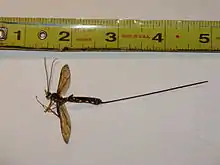Megarhyssa nortoni
Megarhyssa nortoni (common name western giant ichneumon) is a species of large ichneumon wasp.[2]
| Megarhyssa nortoni | |
|---|---|
 | |
| Megarhyssa nortoni female | |
| Scientific classification | |
| Kingdom: | |
| Phylum: | |
| Class: | |
| Order: | |
| Family: | |
| Subfamily: | |
| Genus: | |
| Species: | M. nortoni |
| Binomial name | |
| Megarhyssa nortoni | |
Description
Megarhyssa nortoni is black, reddish brown, and yellow and has distinguishing round yellow spots down the side of the abdomen. Its legs are mostly yellow.[2] Its wings are transparent, and the body is elongated with a length of 1.4 inches (36 mm). The female is notable for an ovipositor of 2 inches (51 mm) to 3 inches (76 mm) in length. The male is less colorful with no ovipositor.[3]
Behavior
Megarhyssa nortoni is a predatory insect. Its larvae are parasitoids of horntail wasp larvae in coniferous trees. The adult female hunts horntail larvae for egg placement. It smells wood-eating fungus, utilized by the horntail larvae to predigest wood pulp, and uses its antennae to detect vibrations made by the horntail larvae. The female M. nortoni curls its ovipositor over its abdomen to insert the tip of the ovipositor at a right angle into the bark and cuts into the tree until it reaches the horntail larval tunnel. The female then deposits a very slender egg through its ovipositor into the tunnel on or near the horntail larva. The M. nortoni larva then hatches to eat the live horntail larval host from the inside causing the horntail larva's eventual death. The M. nortoni larva pupates inside its host and emerges the following summer as an adult.[1][2]
Although imposing, the female M. nortoni does not sting and is harmless to humans. Adult M. nortoni feed on nectar and water.[2][4]
Habitat
This species is found in coniferous forests in Western North America.[2] It has also been introduced to New Zealand, Tasmania, and Brazil to help control horntail forest pests.[4]
References
- jiffynotes.com Retrieved on 2011-09-30.
- Lorus Johnson Milne, Margery Joan Greene Milne (1980). The Audubon Society field guide to North American insects and spiders. Alfred A. Knopf, Inc. pp. 808–809. ISBN 0-394-50763-0.
- Peter Haggard, Judy Haggard (2006). Insects of the Pacific Northwest. Timber Press, Inc. p. 131. ISBN 0-88192-689-2.
- jrank.org Retrieved on 2011-09-30.